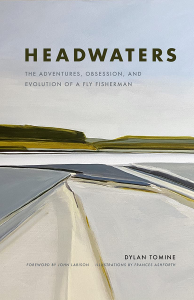Book Excerpt: “Headwaters”

Purchase Headwaters by Dylan Tomine
Three minutes into our float, the V-wakes of submerged rocks in the tailout begin to move, creasing the glassy surface as they peel away from our approaching raft. Skyla and Weston lean forward, scouting ahead. “Are those all fish?” Skyla asks, then, with rising urgency, “They are! Look!” Weston climbs up onto the bow, afraid to miss out. Chaos ensues. I yell at him to keep his feet on the floor; he ignores me and scrambles for position. “There’s one over there!” he hollers, “and two more over there!” Our raft accelerates into the riffle, the glare shifts, and now I can see for myself: king salmon. Lots of them.
The final remnants of the upper dam came down last week; the lower dam was cleared more than a year ago. And we are here to experience the newly free-flowing Elwha River. Despite dire predictions of sediment choking the river with mud, today, the water flows with startling clarity, colored only by the faint blue-green hint of its glacial origins. Clean cobble—from fist- to basketball-sized—covers the bottom; new logjams and gravel bars line the banks.
And in every tailout and flat terrace, there are fish. Descendants of the king salmon we’ve watched for years banging against the lower dam have finally reached their ancestral spawning grounds. While I am sad and disappointed that the continued hatchery operation most likely contributed many of these fish, it is, nonetheless, uplifting to see them here, doing what they were meant to do. I wonder, though, how much stronger and more sustainable this run would be if we’d only had the patience to let Nature repopulate the river on its own. Still, that there are fish here at all feels like a miracle. We watch a thirty-pound female king tip onto her side and, with great tail-flapping exertion, excavate a new redd, or nest. Several males with fearsome, hooked jaws and ragged fins hover nearby, while cutthroat and bull trout hold just downstream, waiting to snatch a salmon-egg meal. The ancient conveyer belt is back in business, delivering rich ocean nutrients to the sterile interior in the form of salmon.
Even as we float the Elwha, I can’t help but imagine this kind of resurgent life on the once-mighty Snake River. There, four enormous, salmon-killing dams have outlasted their useful lifespan and now stand only as grand monuments to hubris. Is it asking too much to want something more than stagnant, warm-water reservoirs and empty tributaries for the Snake? I don’t think so.
We pull over to stretch our legs on a broad gravel bar. While the kids run the shoreline looking for more fish, I stare into the choppy surface at the head of the pool. Perfect steelhead water. As I mentally work through the mends needed to fish the inside seam, I can almost feel my fly swimming through four feet of blue-green water, the line tight on my fingers. When the Elwha reopens to anglers, I will be here in this run—or, given the shifting nature of a new river, one like it—swinging a sink tip with crazed anticipation. In the deepest part of the pool, I can just make out the shadows of pale, chrome salmon, fresh from the sea.
Our afternoon falls into the typical rhythm of a coastal river float: riffle, pool, the occasional joy and adrenaline jolt of small rapids. The kids remain absorbed by their quest to spot fish. Weston keeps count, as is his nature, and loses track when the number reaches triple digits. We are buoyant.
When we reach the takeout, the kids aren’t ready to give up the river just yet. Neither am I. We shed our float gear and pile into the car. Where the Elwha meets the Strait of Juan de Fuca, we walk to the beach. For longer than I can remember, the mouth of the Elwha was a straight, sediment-starved channel pouring abruptly into salt water, but now we find acres of fertile delta—a complex maze of tidal pools, flood ponds, sloughs, and sandbars littered with driftwood.
Tiny salmon, flashing silver in the evening light, leap for insects and create intersecting rings across the smooth surface, a natural Venn diagram of wild salmon survival. We sit in silence, watching baby salmon feed and the new river pushing against the tide. On the far side, an adult king explodes into the air on its way upstream. “Dad?” Weston asks, “can we come back here to fish sometime?” I’m way ahead of you, buddy. Way ahead.
Excerpted from “Headwaters: The Adventures, Obsession, and Evolution of a Fly Fisherman” by Dylan Tomine. Reprinted with permission from Patagonia.
About the Author: Dylan Tomine is a father, writer, conservation advocate and recovering sink tip addict, not necessarily in that order. His book, “Closer to the Ground: An Outdoor Family’s Year on the Water, in the Woods and at the Table,” was a National Outdoor Book Award honorable mention. He is also a producer of the feature-length documentary, “Artifishal,” which has been watched by more than 3.5 million viewers. Dylan lives in Bainbridge Island, Washington.











